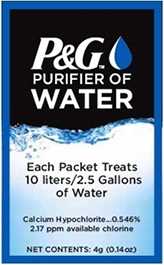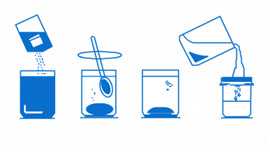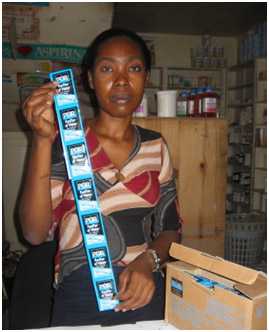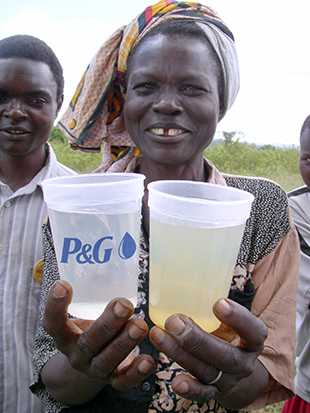Flocculant/Disinfectant Powder

A P&G™ sachet (Proctor & Gamble)
Flocculant/Disinfectant Powder [2 pages]
The Procter & Gamble Company developed P&G Purifier of Water™ in conjunction with the Centers for Disease Control and Prevention (CDC). P&G™ sachets are now centrally produced in Pakistan, and sold to non-governmental organizations (NGOs) worldwide at a cost of 3.5 US cents per sachet. The P&G™ product is a small sachet containing powdered ferric sulfate (a flocculant) and calcium hypochlorite (a disinfectant). P&G™ was designed to reverse-engineer a water treatment plant, incorporating the multiple barrier processes of removal of particles and disinfection. To treat water with P&G™, users open the sachet, add the contents to an open bucket containing 10 liters of water, stir for 5 minutes, let the solids settle to the bottom of the bucket, strain the water through a cotton cloth into a second container, and wait 20 minutes for the hypochlorite to inactivate the microorganisms.
Lab Effectiveness, Field Effectiveness, and Health Impact
The flocculant/disinfectant powder P&G™ has been proven to remove the vast majority of bacteria, viruses, and protozoa, even in highly turbid waters. P&G™ has also been documented to reduce diarrheal disease from 90% to less than 16% incidence in five randomized, controlled health intervention studies. P&G™ also removes heavy metals—such as arsenic—and chemical contaminants—such as pesticides—from water. Studies showing the efficacy of P&G™ have been conducted for highly turbid water in the laboratory, in developing countries, in rural and urban areas, refugee camps, and include all age groups.
Benefits, Drawbacks, and Appropriateness

Process for P&G™ purifier of water system (Proctor & Gamble)
The benefits of Flocculant/Disinfectant Powder are:
- Proven reduction of bacteria, viruses, and protozoa in water
- Removal of heavy metals and chemicals
- Increased free chlorine protection against contamination
- Proven reduction of diarrheal disease
- Visual improvement of water and acceptability
- Transport of sachets easy
- Long shelf life of sachets
The drawbacks of Flocculant/Disinfectant Powder are:
- Multiple steps are necessary—requires training or demonstration
- Requires a lot of equipment (2 buckets, cloth, and a stirrer)
- The higher relative cost per liter of water treated
P&G™ is most appropriate in areas with a consistent supply chain for sachet resupply and in urban, rural, and emergency situations when educational messages can reach users to encourage correct and consistent use.
Implementation Examples

Woman with P&G™ sachets in Haiti (D. Lantagne, CDC)
Social marketing organizations, such as the NGO Population Services International, sell P&G™ sachets in multiple countries.
Local organizations use the socially marketed P&G™ sachets in their own programming to provide safe drinking water. In western Kenya, students in schools are taught how and why to use P&G™, and safe water clubs treat drinking water for all the students. Also in Kenya, HIV self-help groups sell P&G™ sachets and storage containers as an income-generating activity.
P&G™ sachets have been widely used to respond to emergencies – from the 2004 tsunami in Indonesia to flooding in Haiti to cholera epidemics in Africa. The Procter & Gamble Children’s Safe Drinking Water program has been given numerous awards, including the Ron Brown Presidential Award for Corporate Leadership in 2007, the EPA Children’s Health Excellence Award in 2007, the Grainger Challenge Bronze Award in 2007, and the Stockholm Industry Water Award in 2005.
Economics and Scalability

Turbid water in Kenya treated with P&G™ (G. Allgood, Proctor & Gamble)
Each sachet of P&G™ is provided to global emergency relief organizations or non-governmental organizations at a cost of 3.5 US cents, not including shipping from Pakistan by ocean container. Transport, distribution, education, and community motivation can add significantly to program costs. Sachets are generally sold at product cost recovery for 10 US cents each, for a cost of 1 US cent per liter treated. Currently, P&G™ projects operate either on partial cost recovery (charging the user only for the product, and subsidizing program costs with donor funds), or fully subsidized free distribution such as in emergency situations. Procter & Gamble sells the P&G™ sachets at cost, makes no profits on P&G™ sales, and donates programmatic funding to some projects.
References
Chiller TM, Mendoza CE, Lopez MB, Alvarez M, Hoekstra RM, Keswick BH, Luby SP. Reducing diarrhoea in Guatemalan children: randomized controlled trial of flocculant-disinfectant for drinking-water. Bull World Health Organ. 2006; Jan 84(1):28-35.
Crump JA, Otieno PO, Slutsker L, Keswick BH, Rosen DH, Hoekstra RM, Vulule JM, Luby SP. Household based treatment of drinking water with flocculant-disinfectant for preventing diarrhoea in areas with turbid source water in rural western Kenya: cluster randomised controlled trial. BMJ. 2005; Sep 3 331(7515):478.
Luby SP, Agboatwalla M, Painter J, Altar A, Billhimer W, Keswick B, Hoeskstra RM. Combining drinking water treatment and hand washing for diarrhea prevention, a cluster randomized controlled trial. Trop Med Int Health. 2006; Apr 11(4):479-89.
Reller ME, Mendoza CE, Lopez MB, Alvarez M, Hoekstra RM, Olson CA, Baier KG, Keswick BH, Luby SP. A randomized controlled trial of household-based flocculant-disinfectant drinking water treatment for diarrhea prevention in rural Guatemala. Am J Trop Med Hyg. 2003; Oct 69(4):411-9.
Doocy S, Burnham G. Point-of-use water treatment and diarrhea reduction in the emergency context: an effectiveness trial in Liberia. Trop Med Int Health. 2006 Oct; 11(10):1542-52.
Additional Resources
For more information about flocculant/disinfection systems for developing countries visit:
- Page last reviewed: March 12, 2014
- Page last updated: May 2, 2014
- Content Source:


 ShareCompartir
ShareCompartir